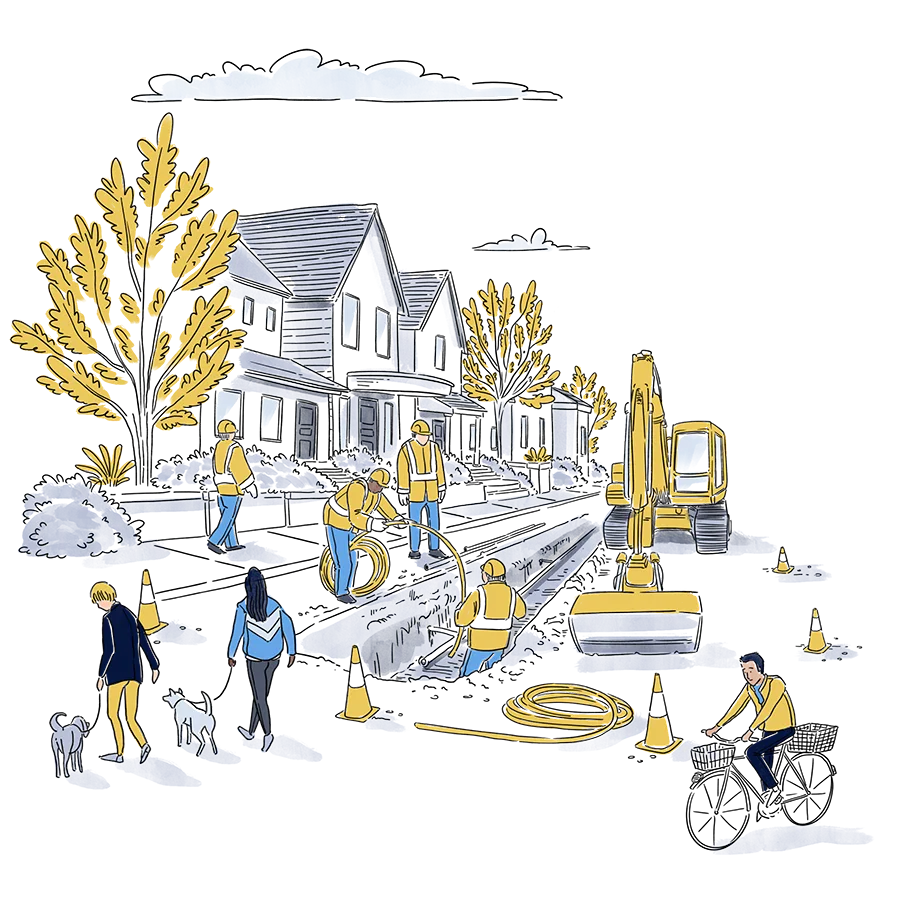Lead Pipes 101
Get the facts. Know the risks. Remove lead pipes for good.
Millions of families across the U.S. unknowingly face an invisible threat in their drinking water: lead pipes.
But there’s good news: we have the knowledge and power to fix this.
Lead in Drinking Water: An Invisible Threat
All families deserve drinking water that isn’t harmful to their health.
From rural towns to large cities, an estimated 9 million homes and businesses across the U.S. still get their water from lead service lines—exposing millions of children and adults to lead and its harmful health impacts.
What are the health impacts of lead?
There is no safe level of lead exposure. Even minuscule amounts measured in parts per billion can harm children’s brain development, causing learning disabilities, lower IQ, attention issues, and behavioral problems. In adults, lead raises the risk of hypertension, heart disease, and pregnancy complications like preeclampsia.
The long-term effects of lead exposure can ripple through your community, impacting educational outcomes and workforce productivity, while increasing costs related to healthcare and other social services.
How does lead end up in drinking water?
Lead doesn’t come from the source water or treatment process—it’s the pipes and plumbing in your home that are the culprits. Lead leaches into drinking water from:
- Lead service lines connecting homes to water mains
- Internal plumbing, including brass fixtures or fittings containing lead
- Lead connectors, like goosenecks and pigtails
Corrosion is the key factor. Acidic water that has low mineral content, or sits stagnant in pipes for too long is more likely to cause lead to leach into the water.
The lead service line, which connects your home to the water main, is the biggest offender. Even in areas with treatment to reduce pipe corrosion lead pipes can still release harmful levels of lead unpredictably—posing an ongoing risk.
What is a service line?
The service line is the pipe that connects your home to the water main. Ownership of the service line is typically, but not always, split between the water utility (AKA “public side”) and property owner (AKA “private side”) based on the property boundary.
What are “full” and “partial” replacements?
A full replacement happens when the lead service line is removed in its entirety—both private and public sides. Partial replacements, on the other hand, occur when only one of the two portions of the line – private or public – is replaced.
Partial replacements happen when only one of the portions of the service line—private or public—is replaced. Partial replacements are potentially harmful since disruptions on either side of the service line can increase lead levels in drinking water.
Why weren’t lead pipes removed when they were first banned?
While the federal government banned new lead plumbing in 1986, until recently, there was no requirement to remove existing lead pipes. Instead, water utilities relied on corrosion control treatment to reduce lead leaching into drinking water.
However, this approach only addresses lead in drinking water without taking into account other major sources of lead such as lead-based paint, contaminated soils and foods, old cookware and toys, etc. This is particularly problematic for under-resourced and low-income communities living in older towns and cities, where the risk of lead exposure from multiple of sources – peeling paint, contaminated soil, and aging water infrastructure – is higher. New regulations now require utilities to find and replace lead service lines, ensuring safer water for everyone.
Are there lead pipes in your community?
Your water utility might already be tackling lead service lines in your neighborhood. Use this interactive map to explore information from over 250 communities sharing public data about their replacement efforts. The map also shows the EPA’s estimate of lead service lines in each state, giving you a clear picture of the problem’s scale.
Don’t see your community listed?
Reach out to your water utility or local government. They were required to submit an inventory of all service lines, including lead, by October 16, 2024. This inventory is a powerful tool for understanding where lead pipes are located and what’s being done to replace them.


An Invisible Threat with a Clear Solution: Get the Lead Out!
The biggest source of lead in drinking water? Lead pipes. The solution? Remove them. With growing funding, public support, and new federal regulations, we can clear this hazard from our communities—fast.
What are the current requirements for replacing lead pipes?
Lead service line (LSL) replacement is guided by strengthened federal and state regulations aimed at protecting public health.
Federal Requirements
The EPA’s 1991 Lead and Copper Rule (LCR) set the stage for monitoring lead and copper levels in drinking water. Two major updates have since expanded protections:
Lead and Copper Rule Revisions (LCRR)
- Service line inventories: Water systems must identify and inventory all lead service lines. Service lines must be classified as one of the following material categories: Lead, non-lead (e.g., copper, plastic, galvanized), galvanized requiring replacement, or lead status unknown. Compliance date: October 16, 2024
- Public notification: Utilities must notify residents and local health officials about the presence of lead pipes.
Lead and Copper Rule Improvements (LCRI)
- 10-Year Replacement Deadline: Most water utilities must replace all lead and galvanized lines within a decade.
- Full Replacement Required: Partial replacements are no longer allowed.
- Stricter Action Level: The lead action level drops from 15 to 10 parts per billion (ppb), triggering faster intervention if exceeded.
State Requirements
Several states have gone beyond federal requirements, establishing their own lead pipe replacement mandates and support:
- 100% Replacement: Illinois, Michigan, Rhode Island, and New Jersey require complete lead pipe removal, including both public and private sides of the service line, with specific deadlines for replacement.
- 10-Year Deadline with State Funding: Minnesota mandates all lead service lines be removed by 2033 and provides funding to achieve this goal.
- Utility Access to Conduct Replacements: Indiana allows tenants to grant utility access for lead pipe removal under certain circumstances.
- Transparency & Tracking: Illinois, New York, and Minnesota mandate transparent and public LSL inventories.
- Pioneering Funding Program: Wisconsin, the first state to dedicate federal funds to LSL replacement, now offers a $4 million community outreach grant program. Minnesota dedicated $240 million for lead pipe replacement.
Contact your local water utility to learn more about specific requirements, available funding, and replacement programs in your area.
What else can be done to protect the public from lead in drinking water?
Lead pipe replacement is the most effective way to reduce the risk of lead exposure from drinking water. However, water utilities across the country are taking additional measures to ensure safe drinking water for their community:
Corrosion control treatment
This involves adding chemicals to water at the treatment plant. These chemicals promote the formation of a protective scale inside pipes, which helps prevent lead from leaching into the water. While corrosion control treatment is an effective strategy, it must be carefully managed, as changes in water chemistry or poor oversight can compromise its effectiveness and increase the risk of lead release. Even after all lead service lines are removed, corrosion control treatment may still be necessary, since, depending on the water’s characteristics, lead can still leach from in-home plumbing such as pipes, fixtures, or lead solder.
Pitcher and filter distribution
Many water systems provide residents with water pitchers and are certified as an added layer of protection – especially following disruptions to their service lines from replacements or repairs. These disruptions can temporarily increase lead levels in tap water, and filters help reduce exposure during this vulnerable period.
Make information accessible to all
Clear, accessible information helps residents understand their risk, what to expect from a lead pipe replacement program, and who to contact for support. It’s essential for protecting public health and ensuring program success. Residents often want to know:
- How to protect their health before and after replacement
- What the work involves
- What it will cost them
To learn more about key questions residents are likely to ask see Water Utilities Roadmap, Principle 4, Key Action 2.
Need More Reasons? Here’s Why Replacing Lead Pipes Pays Off
In addition to the public health benefits, removing lead pipes from water distribution systems:
Avoids costly public health crises
Proactive lead service line replacement helps avoid costly crisis responses like bottled water distribution, emergency public communications, legal action, and long-term damage to public trust. Beyond preventing emergencies, these investments can yield significant economic benefits by reducing the incidence of lead-related conditions, including cardiovascular disease and neurodevelopmental impacts that affect mental health.
Delivers a 3:1 return on investment in health savings
A 2020 Environmental Defense Fund analysis found that every lead pipe replaced yields an estimated $22,000 in cardiovascular-related public health benefits. In addition, removing lead pipes improves IQ and lifetime earnings, and lower spending on special education and criminal justice.
Boosts property values by up to 5%
Reliable access to safe water can increase home values by as much as 5%, according to a 2018 University of Pittsburgh study. In contrast, homes with lead pipes are increasingly seen as liabilities, with growing public concern reducing their market appeal.
Can create thousands of local jobs
Lead pipe replacement is a proven economic driver, projected to create up to 224,500 jobs and generate $23 billion in economic activity in Illinois alone, according to the Metropolitan Planning Council. This economic activity can be especially impactful for unemployed and low-income residents.
Saves billions in water loss
Aging lead pipes leak, driving up maintenance costs, wasting valuable water, and reducing much-needed utility revenue. Replacing them can lead to massive savings. An Ohio Environmental Council analysis estimates the state’s utilities could save up to $82 billion by replacing all lead pipes in 15 years.